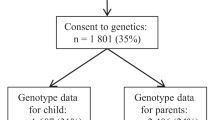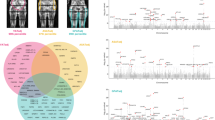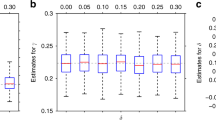Abstract
Background/objectives
Quantile-dependent expressivity occurs when a gene’s phenotypic expression depends upon whether the trait (e.g., BMI) is high or low relative to its distribution. We have previously shown that the obesity effects of a genetic risk score (GRSBMI) increased significantly with increasing quantiles of BMI. However, BMI is an inexact adiposity measure and GRSBMI explains <3% of the BMI variance. The purpose of this paper is to test BMI for quantile-dependent expressivity using a more inclusive genetic measure (h2, heritability in the narrow sense), extend the result to other adiposity measures, and demonstrate its consistency with purported gene–environment interactions.
Subjects/methods
Quantile-specific offspring–parent regression slopes (βOP) were obtained from quantile regression for height (ht) and computed tomography (CT), dual-energy x-ray absorptiometry (DXA), anthropometric, and bioelectrical impedance (BIA) adiposity measures. Heritability was estimated by 2βOP/(1 + rspouse) in 6227 offspring–parent pairs from the Framingham Heart Study, where rspouse is the spouse correlation.
Results
Compared to h2 at the 10th percentile, genetic heritability was significantly greater at the 90th population percentile for BMI (3.14-fold greater, P < 10−15), waist girth/ht (3.27-fold, P < 10−15), hip girth/ht (3.12-fold, P = 6.3 × 10−14), waist-to-hip ratio (1.75-fold, P = 0.01), sagittal diameter/ht (3.89-fold, P = 3.7 × 10−7), DXA total fat/ht2 (3.62-fold, P = 0.0002), DXA leg fat/ht2 (3.29-fold, P = 2.0 × 10−11), DXA arm fat/ht2 (4.02-fold, P = 0.001), CT-visceral fat/ht2 (3.03-fold, P = 0.002), and CT-subcutaneous fat/ht2 (3.54-fold, P = 0.0004). External validity was suggested by the phenomenon’s consistency with numerous published reports. Quantile-dependent expressivity potentially explains precision medicine markers for weight gain from overfeeding or antipsychotic medications, and the modifying effects of physical activity, sleep, diet, polycystic ovary syndrome, socioeconomic status, and depression on gene–BMI relationships.
Conclusions
Genetic heritabilities of anthropometric, CT, and DXA adiposity measures increase with increasing adiposity. Some gene–environment interactions may arise from analyzing subjects by characteristics that distinguish high vs. low adiposity rather than the effects of environmental stimuli on transcriptional and epigenetic processes.
This is a preview of subscription content, access via your institution
Access options
Subscribe to this journal
Receive 12 print issues and online access
$259.00 per year
only $21.58 per issue
Buy this article
- Purchase on Springer Link
- Instant access to full article PDF
Prices may be subject to local taxes which are calculated during checkout




Similar content being viewed by others
References
Williams PT. Quantile-specific penetrance of genes affecting lipoproteins, adiposity and height. PLoS ONE. 2012;7:e28764.
Williams PT. Quantile-specific heritability may account for gene-environment interactions involving coffee consumption. Behav Genet. 2020;50:119–26.
Williams PT. Gene-environment interactions due to quantile-specific heritability of triglyceride and VLDL concentrations. Sci Rep. 2020;10:4486.
Williams PT. Quantile-dependent expressivity of postprandial lipemia. PLoS ONE. 2020;15:e0229495.
Falconer DS, Mackay TFC. Introduction to quantative genetics. 4th ed. London: Pearson Education Limited; 2004.
Rokholm B, Silventoinen K, Ängquist L, Skytthe A, Kyvik KO, Sørensen TI. Increased genetic variance of BMI with a higher prevalence of obesity. PLoS ONE. 2011;6:e20816.
Abadi A, Alyass A, Robiou du Pont S, Bolker B, Singh P, Mohan V, et al. Penetrance of polygenic obesity susceptibility loci across the body mass index distribution. Am J Hum Genet. 2012;101:925–38.
Beyerlein A, von Kries R, Ness AR, Ong KK. Genetic markers of obesity risk: stronger associations with body composition in overweight compared to normal-weight children. PLoS ONE. 2011;6:e19057.
Mitchell JA, Hakonarson H, Rebbeck TR, Grant SFA. Obesity-susceptibility loci and the tails of the pediatric BMI distribution. Obesity. 2013;21:1256–60.
Reddon H, Guéant JL, Meyre D. The importance of gene-environment interactions in human obesity. Clin Sci. 2016;130:1571–97.
Youngson NA, Morris MJ. What obesity research tells us about epigenetic mechanisms. Philos Trans R Soc Lond B Biol Sci. 2013;368:20110337.
Shuster A, Patlas M, Pinthus JH, Mourtzakis M. The clinical importance of visceral adiposity: a critical review of methods for visceral adipose tissue analysis. Br J Radiol. 2012;85:1–10.
Snijder MB, Visser M, Dekker JM, Seidell JC, Fuerst T, Tylavsky F, et al. The prediction of visceral fat by dual-energy X-ray absorptiometry in the elderly: a comparison with computed tomography and anthropometry. Int J Obes Relat Metab Disord. 2002;26:984–93.
Kannel WB, Feinleib M, McNamara PM, Garrison RJ, Castelli WP. An investigation of coronary heart disease in families. The Framingham offspring study. Am J Epidemiol. 2006;110:281–90.
Schousboe K, Willemsen G, Kyvik KO, Mortensen J, Boomsma DI, Cornes BK. Sex differences in heritability of BMI: a comparative study of results from twin studies in eight countries. Twin Res. 2003;6:409–21.
Fox CS, Massaro JM, Hoffmann U, Pou KM, Maurovich-Horvat P, Liu CY, et al. Abdominal visceral and subcutaneous adipose tissue compartments: association with metabolic risk factors in the Framingham Heart Study. Circulation. 2007;116:39–48.
Locke AE, Kahali B, Berndt SI, Justice AE, Pers TH, Day FR, et al. Genetic studies of body mass index yield new insights for obesity biology. Nature. 2015;518:197–206.
Koenker R, Hallock KF. Quantile regression. J Econ Perspect. 2001;15:143–56.
Rask-Andersen M, Karlsson T, Ek WE, Johansson Å. Gene-environment interaction study for BMI reveals interactions between genetic factors and physical activity, alcohol consumption and socioeconomic status. PLoS Genet. 2017;13:e1006977.
Rokholm B, Silventoinen K, Tynelius P, Gamborg M, Sørensen TI, Rasmussen F. Increasing genetic variance of body mass index during the Swedish obesity epidemic. PLoS ONE. 2011;6:e27135.
Guo G, Liu H, Wang L, Shen H, Hu W. The genome-wide influence on human BMI depends on physical activity, life course, and historical period. Demography. 2015;52:1651–70.
Kilpelainen TO, Qi L, Brage S, Sharp SJ, Sonestedt E, Demerath E, et al. Physical activity attenuates the influence of FTO variants on obesity risk: a meta-analysis of 218,166 adults and 19,268 children. PLoS Med. 2011;8:e1001116.
Ahmad S, Rukh G, Varga TV, Ali A, Kurbasic A, Shungin D, et al. Gene × physical activity interactions in obesity: combined analysis of 111,421 individuals of European ancestry. PLoS Genet. 2013;9:e1003607.
Qi Q, Li Y, Chomistek AK, Kang JH, Curhan GC, Pasquale LR, et al. Television watching, leisure time physical activity, and the genetic predisposition in relation to body mass index in women and men. Circulation. 2012;126:1821–7.
Graff M, North KE, Richardson AS, Young KM, Mohlke KL, Lange LA, et al. Screen time behaviours may interact with obesity genes, independent of physical activity, to influence adolescent BMI in an ethnically diverse cohort. Pediatr Obes. 2013;8:e74–9.
Banks E, Jorm L, Rogers K, Clements M, Bauman A. Screen-time, obesity, ageing and disability: findings from 91266 participants in the 45 and Up Study. Public Health Nutr. 2011;14:34–43.
Klimentidis YC, Arora A, Chougule A, Zhou J, Raichlen DA. FTO association and interaction with time spent sitting. Int J Obes. 2016;40:411–6.
Watson NF, Harden KP, Buchwald D, Vitiello MV, Pack AI, Weigle DS, et al. Sleep duration and body mass index in twins: a gene-environment interaction. Sleep. 2012;35:597–603.
Young AI, Wauthier F, Donnelly P. Multiple novel gene-by-environment interactions modify the effect of FTO variants on body mass index. Nat Commun. 2016;7:12724.
Wojciechowski P, Lipowska A, Rys P, Ewens KG, Franks S, Tan S, et al. Impact of FTO genotypes on BMI and weight in polycystic ovary syndrome: a systematic review and meta-analysis. Diabetologia. 2012;55:2636–45.
Speliotes EK, Willer CJ, Berndt SI, Monda KL, Thorleifsson G, Jackson AU, et al. Association analyses of 249,796 individuals reveal 18 new loci associated with body mass index. Nat. Genet. 2010;42:937–48.
Frayling TM, Timpson NJ, Weedon MN, Zeggini E, Freathy RM, Lindgren CM, et al. A common variant in the FTO gene is associated with body mass index and predisposes to childhood and adult obesity. Science. 2007;316:889–94.
Tan S, Scherag A, Janssen OE, Hahn S, Lahner H, Dietz T, et al. Large effects on body mass index and insulin resistance of fat mass and obesity associated gene (FTO) variants in patients with polycystic ovary syndrome (PCOS). BMC Med Genet. 2010;11:12.
Barber TM, Bennett AJ, Groves CJ, Sovio U, Ruokonen A, Martikainen H, et al. Association of variants in the fat mass and obesity associated (FTO) gene with polycystic ovary syndrome. Diabetologia. 2008;51:1153–8.
Ahmad T, Lee IM, Paré G, Chasman DI, Rose L, Ridker PM, et al. Lifestyle interaction with fat mass and obesity-associated (FTO) genotype and risk of obesity in apparently healthy U.S. women. Diabetes Care. 2011;34:675–80.
Celis-Morales CA, Lyall DM, Gray SR, Steell L, Anderson J, Iliodromiti S, et al. Dietary fat and total energy intake modifies the association of genetic profile risk score on obesity: evidence from 48,170 UK Biobank participants. Int J Obes. 2017;41:1761–8.
Ding M, Ellervik C, Huang T, Jensen MK, Curhan GC, Pasquale LR, et al. Diet quality and genetic association with body mass index: results from 3 observational studies. Am J Clin Nutr. 2018;108:1291–300.
Qi Q, Chu AY, Kang JH, Huang J, Rose LM, Jensen MK, et al. Fried food consumption, genetic risk, and body mass index: gene-diet interaction analysis in three US cohort studies. BMJ. 2014;348:g1610.
Qi Q, Chu AY, Kang JH, Jensen MK, Curhan GC, Pasquale LR, et al. Sugar-sweetened beverages and genetic risk of obesity. N Engl J Med. 2012;367:1387–96.
Brunkwall L, Chen Y, Hindy G, Rukh G, Ericson U, Barroso I, et al. Sugar-sweetened beverage consumption and genetic predisposition to obesity in 2 Swedish cohorts. Am J Clin Nutr. 2016;104:809–15.
Qi Q, Downer MK, Kilpeläinen TO, Taal HR, Barton SJ, Ntalla I, et al. Dietary intake, FTO genetic variants, and adiposity: a combined analysis of Over 16,000 Children and adolescents. Diabetes. 2015;64:2467–76.
Corella D, Peloso G, Arnett DK, Demissie S, Cupples LA, Tucker K, et al. APOA2, dietary fat, and body mass index: replication of a gene-diet interaction in 3 independent populations. Arch Intern Med. 2009;9:1897–906.
Corella D, Arnett DK, Tucker KL, Kabagambe EK, Tsai M, Parnell LD, et al. A high intake of saturated fatty acids strengthens the association between the fat mass and obesity-associated gene and BMI. J Nutr. 2011;141:2219–25.
Jääskeläinen A, Schwab U, Kolehmainen M, Kaakinen M, Savolainen MJ, Froguel P, et al. Meal frequencies modify the effect of common genetic variants on body mass index in adolescents of the northern Finland birth cohort 1986. PLoS ONE. 2013;8:e73802.
Tovar A, Emond JA, Hennessy E, Gilbert-Diamond D. An FTO gene variant moderates the association between parental restriction and child BMI. PLoS ONE. 2016;11:e0155521.
Frank M, Dragano N, Arendt M, Forstner AJ, Nöthen MM, Moebus S, et al. A genetic sum score of risk alleles associated with body mass index interacts with socioeconomic position in the Heinz Nixdorf Recall Study. PLoS ONE. 2019;14:e0221252.
Corella D, Carrasco P, Sorlí JV, Coltell O, Ortega-Azorín C, Guillén M, et al. Education modulates the association of the FTO rs9939609 polymorphism with body mass index and obesity risk in the Mediterranean population. Nutr Metab Cardiovasc Dis. 2012;22:651–8.
Johnson W, Krueger RF. Genetic effects on physical health: lower at higher income levels. Behav Genet. 2005;35:579–90.
Rivera M, Locke AE, Corre T, Czamara D, Wolf C, Ching-Lopez A, et al. Interaction between the FTO gene, body mass index and depression: meta-analysis of 13701 individuals. Br J Psychiatry. 2017;211:70–6.
Phillips CM, Kesse-Guyot E, McManus R, Hercberg S, Lairon D, Planells R, et al. High dietary saturated fat intake accentuates obesity risk associated with the fat mass and obesity-associated gene in adults. J Nutr. 2012;142:824–31.
Taylor AE, Sandeep MN, Janipalli CS, Giambartolomei C, Evans DM, Kranthi Kumar MV, et al. Associations of FTO and MC4R variants with obesity traits in Indians and the role of rural/urban environment as a possible effect modifier. J Obes. 2011;2011:307542.
Yajnik CS, Janipalli CS, Bhaskar S, Kulkarni SR, Freathy RM, Prakash S, et al. FTO gene variants are strongly associated with type 2 diabetes in South Asian Indians. Diabetologia. 2009;52:247–52.
Latella MC, Di Castelnuovo A, de Lorgeril M, Arnout J, Cappuccio FP, Krogh V, et al. Genetic variation of alcohol dehydrogenase type 1C (ADH1C), alcohol consumption, and metabolic cardiovascular risk factors: results from the IMMIDIET study. Atherosclerosis. 2009;207:284–90.
Levitan RD, Masellis M, Lam RW, Kaplan AS, Davis C, Tharmalingam S, et al. A birth-season/DRD4 gene interaction predicts weight gain and obesity in women with seasonal affective disorder: a seasonal thrifty phenotype hypothesis. Neuropsychopharmacology. 2006;31:2498–503.
Young KL, Graff M, North KE, Richardson AS, Mohlke KL, Lange LA, et al. Interaction of smoking and obesity susceptibility loci on adolescent BMI: The National Longitudinal Study of Adolescent to Adult Health. BMC Genet. 16.
Terán-García M, Després JP, Tremblay A, Bouchard C. Effects of cholesterol ester transfer protein (CETP) gene on adiposity in response to long-term overfeeding. Atherosclerosis. 2008;196:455–60.
Kuzman MR, Medved V, Bozina N, Grubišin J, Jovanovic N, Sertic J. Association study of MDR1 and 5-HT2C genetic polymorphisms and antipsychotic-induced metabolic disturbances in female patients with schizophrenia. Pharmacogenom J. 2011;11:35–44.
Williams PT, Satariano WA. Relationships of age and weekly running distance to BMI and circumferences in 41,582 physically active women. Obes Res. 2005;13:1370–80.
Williams PT. Evidence that obesity risk factor potencies are weight dependent, a phenomenon that may explain accelerated weight gain in western societies. PLoS ONE. 2011;6:e27657.
Acknowledgements
We are grateful to the efforts of the investigators and staff of the Framingham Heart Study who collected the data used in these analyses. This paper was prepared using Framingham Heart Study Research Materials obtained from the National Heart, Lung, and Blood Institute (NHLBI) Biologic Specimens and Data Repository Information Coordinating Center. The Framingham Heart Study is conducted and supported by the NHLBI in collaboration with Boston University (Contract Nos. N01-HC-25195 and HHSN268201500001I). Funding support for the Framingham Whole Body and Regional Dual X-ray Absorptiometry (DXA) dataset was provided by NIH grants R01 AR/AG 41398. This paper was not prepared in collaboration with investigators of the Framingham Heart Study and does not necessarily reflect the opinions or views of the Framingham Heart Study, Boston University, or NHLBI.
Funding
This research was supported by NIH grant R21ES020700 from the National Institute of Environmental Health Sciences, and an unrestricted gift from HOKA ONE ONE.
Author information
Authors and Affiliations
Corresponding author
Ethics declarations
Conflict of interest
The author declares that he has no conflict of interest.
Additional information
Publisher’s note Springer Nature remains neutral with regard to jurisdictional claims in published maps and institutional affiliations.
Rights and permissions
About this article
Cite this article
Williams, P.T. Quantile-dependent heritability of computed tomography, dual-energy x-ray absorptiometry, anthropometric, and bioelectrical measures of adiposity. Int J Obes 44, 2101–2112 (2020). https://doi.org/10.1038/s41366-020-0636-1
Received:
Revised:
Accepted:
Published:
Issue Date:
DOI: https://doi.org/10.1038/s41366-020-0636-1
This article is cited by
-
Individualised prescription of medications for treatment of obesity in adults
Reviews in Endocrine and Metabolic Disorders (2023)
-
The heritability of BMI varies across the range of BMI—a heritability curve analysis in a twin cohort
International Journal of Obesity (2022)
-
Quantile-Dependent Expressivity of Serum Interleukin-6 Concentrations as a Possible Explanation of Gene-Disease Interactions, Gene-Environment Interactions, and Pharmacogenetic Effects
Inflammation (2022)
-
Quantile-specific heritability of sibling leptin concentrations and its implications for gene-environment interactions
Scientific Reports (2020)



